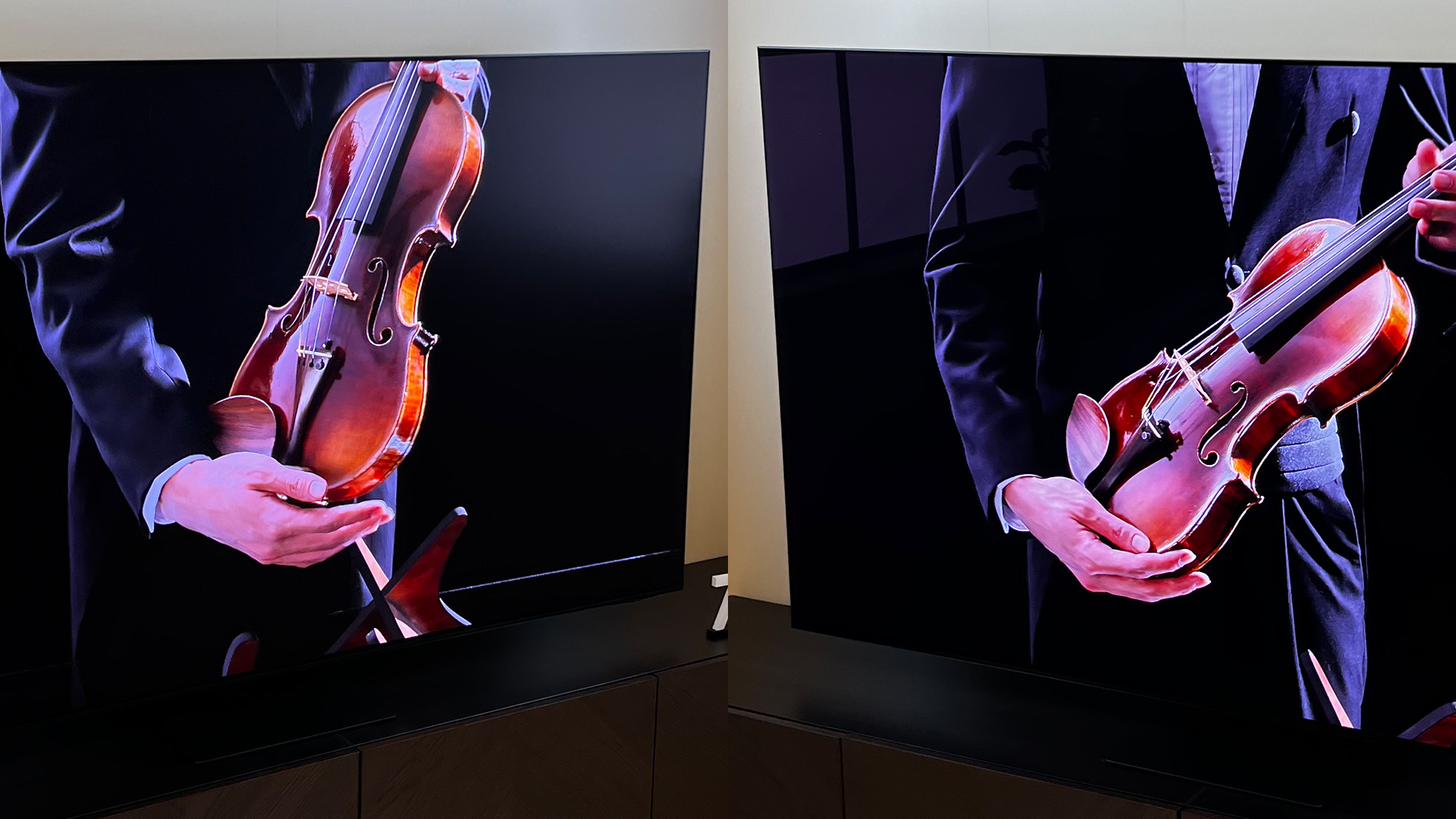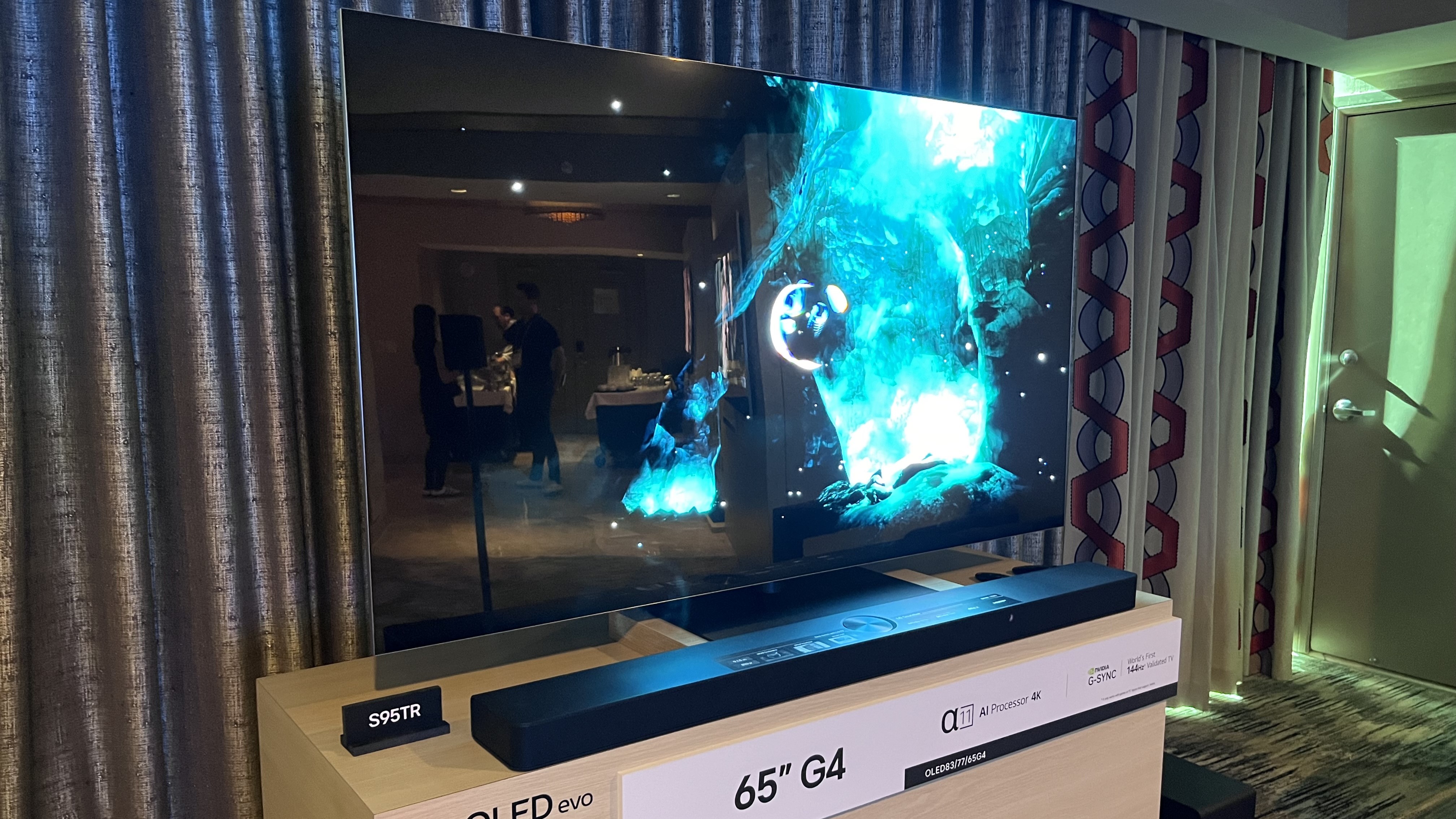LG G4 vs Samsung S95D: how do 2024's flagship OLED TVs compare?
If you're looking for a high-end OLED, the big question is LG G4 vs Samsung S95D, so let's dig into it

All of the biggest and best TV makers revealed their 2024 line-up at the CES tech show in January, including LG and Samsung. Both tech companies are bringing out TVs to suit a range of price points and preferences. But it's often the more premium displays that have the most exciting tech advances, performance upgrades and competitive specs.
This year, those premium displays are the LG G4 and the Samsung S95D. But how will these two TVs compare? And which high-end television is going to be right for you and your home? Well, we won't know for sure until we've had some serious hands-on time with both TVs, but we can make some good guesses.
The LG G4 follows the LG G3, which was one of the best OLED TVs in 2023, it had a combination of high peak brightness, top gaming features and a premium design. We’re excited to see what the G4 has in store, as it promises a boost to performance and usability. But last year’s model set the bar high.

The Samsung S95D follows the Samsung S95C. Like the LG G3, this was one of the best-performing TVs of last year. It was our premium OLED of choice in our best TV guide. It was an impressive TV with a bright and colorful picture and a load of great features, especially for gamers.
We may not be able to say yet which TV we've recommend. But, based on what we know so far and previous models, which is likely to be the better TV, the LG G4 vs Samsung S95D?
LG G4 vs Samsung S95D: Price, sizes and release date
In late February, Samsung revealed the first prices we'd seen for the S95D. It was in Euros but it was our first sign that its 2024 TV range had seen a price increase from last year's models, and the S95D was not spared from this. By late March, we had confirmation for its US pricing, which confirmed the price bump. See below:
- 55-inch: $2,599 (around £2,050 / AU$3,975)
- 65-inch: $3,399 (around £2,690 / AU$5,200)
- 77-inch: $4,599 (around £3,640 / AU$7,035)
It's the same story for the LG G4. The new set has seen a price hike, which could be down to the performance and tech upgrades that LG has made. Price-wise, the G-series sits below the M-series, so it’s one of the brand’s best OLEDS.
Sign up for breaking news, reviews, opinion, top tech deals, and more.
Last year, the price of the LG G3 dropped but was high compared to some other OLEDs. However, it did also stay competitively priced to the similarly specced Sony A95L and Samsung S95C. Although, in our LG G3 review, we did say that as much as we loved the G3 it didn’t feel as good value as the Samsung S95C.
Could that be the same this year? We won't have an official stance on this until our full reviews come in but looking at the pricing of the G4 – LG first announced the US pricing for the set before later revealing how much it will cost in the UK and Australia – both TV makers are putting the sets directly head-to-head on the value front. See the LG G4 pricing below:
- OLED55G4: $2,599 / £2,399 / AU$4,199
- OLED65G4: $3,399 / £3,299 / AU$5,299
- OLED77G4: $4,599 / £4,490 / AU$7,999
- OLED83G4: $6,499 / £7,000 / AU$9,999
- OLED97G4: $24,999 / (around £19,522; AU availability TBC)

LG G4 vs Samsung S95D: Features
Let's start with the LG G4. There’s a next-gen MLA (Micro Lens Array) OLED panel coming in the 55-, 65-, 77- and 83-inch sizes of the G4s (the 83-inch missed out on this panel with the G3), which is expected to bring a brightness upgrade. However, the 97-inch screen will miss out.
There’s also a new Alpha 11 processor in both the new LG G4 and LG M4 TVs. LG promises this is going to bring us four times the power of the Alpha 9 processor – which is in the new LG C4 TVs.
We also know that the LG G4 will come with the new version of LG’s webOS, like all of the brand's 2024 TVs. This is going to includes Quick Cards, which are hubs on the TV’s home screen for app categories, like sports and games. There’s also a new Voice ID recognition feature, this allows you to switch between viewer profiles with voice commands.
One of the biggest bugbears we had with the LG G3 was that it didn’t come with a stand. But the G4 ships with a stand for both the 55- and 65-inch versions of the G4, and the larger models come with a wall mount. This might sound like a small upgrade, but will be a significant one when comparing this TV to other options.

The refresh rate of the LG G4 will be getting a bump from the C3’s 120Hz to 144Hz. Good news for PC gamers. It also still has four HDMI 2.1 ports, the LG Game Optimiser menu, ALLM and VRR. Other notable specs include HDR10, HLG and Dolby Vision.
From what we can tell so far, Samsung's S95D offers more than enough to compete with the LG G4. The Samsung S95D has Samsung’s 3rd-gen QD-OLED screen panel, which is going to be the brightest from Samsung yet. It also has an anti-reflection coating for more vibrant and clear pictures.
Like the LG G4, the Samsung S95D is another solid option for gamers. It has Samsung’s updated Game Bar 4.0 with a new AI Auto Mode, using AI to adjust gaming settings and better suit the genre of whatever you’re playing. We can also expect many of the top gaming features of the S95C, too, like 4K 144Hz compatibility, AMD FreeSync Premium Pro and four HDMI 2.1 ports.
As with all Samsung TVs, there’s no Dolby Vision support on the S95D, which the LG G4 above does have. However, you’ll get HDR10+, HDR10 and HLG support.
LG G4 vs Samsung S95D: Picture quality
LG Display (the part of LG that makes the panels) says that the next-gen MLA (Micro Lens Array) OLED panel in the LG G4 may be able to hit 3,000 nits of peak brightness.
We’ll have to see whether that bold claim delivers in person. We haven’t had chance to see the G4's display for long, but in our LG G4 demo we described the picture as “bright” and “punchy”. We also said that “images popped in a dynamic manner.” This is the kind of picture we’d expect to see from a top-tier TV.
The brighter panel and the new processor make a Max Peak Highlighter feature in the LG G4 possible. This promises to enhance brightness by up to 150% compared to conventional standard OLEDs (like the LG B4) for HDR highlights.

The LG G4's new processor also brings an AI Picture Pro mode with some cool new features. One better defines objects on screen and another analyzes your picture to enhance colors based on the director’s intent.
The Samsung S95D will have a 3rd Gen QD-OLED panel. When we had a Samsung S95D demo, we were impressed with the new anti-reflection screen coating on the screen. The TV was set up near simulated windows to really show off these improvements over an older Samsung TV. We thought it look good, but did comment that this might not be as impressive as the anti-reflection tech you’d find in micro lens array OLED panels, which the LG G4 has.
We can also expect improved brightness from the S95D. This was visible during the demo, particularly during scenes when there was lots of contrast. Samsung told us that the 2024 QD-OLEDs will be 20% brighter than its 2023 TVs. The S95D may even be able to reach 1,600 nits of peak brightness in a 10% HDR window – that’s compared to the 1,400 nits of the S95C.
LG G4 vs Samsung S95D: Sound quality
One of our only criticisms of the LG G3 was the sound. It wasn’t terrible, but we said in our review you’d definitely need one of the best soundbars with this TV.
The new Alpha 11 AI Processor in the G4 will bring us virtual 11.1.2-channel Dolby Atmos sound – the G3 only had 9.1.2 channels. There’s also a new voice remastering feature that can isolate and enhance dialogue.
When the G4 is paired with high-end soundbars, the wireless lossless Dolby Atmos and DTS audio output will also be supported.
In comparison, Samsung S95C had a better sound system that the LG G3. But we don’t know much about the sound on offer from the Samsung S95D.
We can expect the same speaker configurations as last year, that’s 4.2.2 channels of audio. This is no bad thing considering we described the “wall of sound” delivered by the S95C as “engaging and cinematic” in our review.
LG G4 vs Samsung S95D: Verdict

The LG G3 was an almost-perfect TV in our books. Which means if the LG G4 packs in enhancements to its performance, picture and usability, it could be one of our best TVs of 2024 – especially now it offers a stand.
Having said that, there’s stiff competition from other brands as well as LG’s own range. The LG C4 might be a step down from the G4, but with many improvements on last year’s C3 that might be a better option for most people unless they really need the high-end performance of the G4.
None of that is to say the LG G4 is going to beat the Samsung S95D. The Samsung S95C that came before it was also one of the best TVs of 2023, and our top pick for the best premium OLED. We’ll need a hands-on with this new Samsung display to know for sure, but this could easily be our best high-end option for the next 12 months.
You might also like

Becca is a contributor to TechRadar, a freelance journalist and author. She’s been writing about consumer tech and popular science for more than ten years, covering all kinds of topics, including why robots have eyes and whether we’ll experience the overview effect one day. She’s particularly interested in VR/AR, wearables, digital health, space tech and chatting to experts and academics about the future. She’s contributed to TechRadar, T3, Wired, New Scientist, The Guardian, Inverse and many more. Her first book, Screen Time, came out in January 2021 with Bonnier Books. She loves science-fiction, brutalist architecture, and spending too much time floating through space in virtual reality.